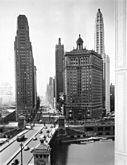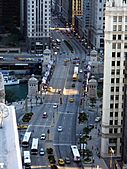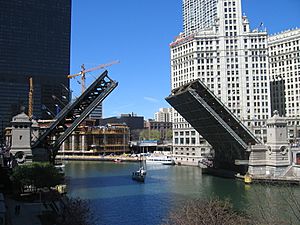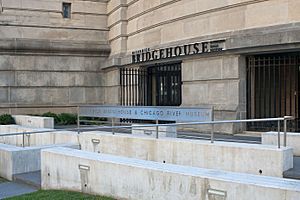DuSable Bridge facts for kids
Quick facts for kids DuSable Bridge |
|
|---|---|
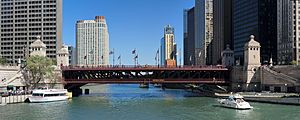
DuSable (Michigan Avenue) Bridge viewed from the west
|
|
| Coordinates | 41°53′19.9″N 87°37′27.7″W / 41.888861°N 87.624361°W |
| Carries | Michigan Avenue |
| Crosses | Chicago River |
| Locale | Chicago |
| Heritage status | Chicago Landmark |
| ID number | 000016612026812 |
| Characteristics | |
| Design | Double-leaf, double-deck, fixed counterweight, trunnion bascule bridge |
| Total length | 399 feet (122 m) |
| Width | 91.75 feet (27.97 m) |
| Longest span | 256 feet (78 m) between trunnions 220 feet (67 m) between piers |
| Clearance below | 16 feet (4.9 m) |
| History | |
| Designer | Bureau of Engineering, Chicago Department of Public Works |
| Construction begin | April 15, 1918 |
| Construction end | 1920 |
| Opened | May 14, 1920 |
| Statistics | |
| Daily traffic | 37900 (upper deck) 11700 (lower deck) |
The DuSable Bridge is a special kind of bridge called a bascule bridge. This means it can open up to let tall boats pass underneath. It carries Michigan Avenue across the Chicago River in downtown Chicago, Illinois.
This bridge was first planned in the early 1900s. It was part of a big idea to connect Chicago's north and south sides with a grand street. Building started in 1918, and the bridge opened in 1920. Later, in 1928, cool decorations were added. The DuSable Bridge is unique because it has two levels for cars and people. It's also known as a "Chicago style bascule bridge." It's a very important landmark in Chicago.
The area around the bridge is historically significant. On the north side, it's near where Jean Baptiste Point du Sable, Chicago's first permanent resident, lived in the 1780s. On the south side, it's close to where Fort Dearborn stood in the early 1800s. The bridge has sculptures and plaques that tell stories from Chicago's past. You can even visit a museum inside one of the bridge's towers to learn more!
Contents
Where is the DuSable Bridge Located?
The DuSable Bridge runs north and south over the main part of the Chicago River. It connects two important areas of Chicago: the Near North Side and the Loop.
On the north side, the bridge is at the start of the famous Magnificent Mile. Here you can see the Wrigley Building and Tribune Tower. On the south side, it meets Wacker Drive. The London Guarantee Building and 333 North Michigan overlook this spot. Nearby bridges include the Columbus Drive Bridge to the east and the Wabash Avenue Bridge to the west.
A Place Full of History
This bridge stands in a very historic spot. The north end covers part of the Jean Baptiste Point Du Sable Homesite. A special plaque in Pioneer Court remembers this. The south half of the bridge crosses over the site of Fort Dearborn. This fort was built in 1803. You can see a large relief (a type of sculpture) about the fort on the London Guarantee Building. Brass markers on the sidewalks also show where the fort's original blockhouse might have been.
How Did the Bridge Get its Name?
The bridge's location has led to many ideas for its name over the years. In 1921, some suggested naming it the Marquette–Joliet Bridge. In 1939, another idea was the Fort Dearborn Bridge. But these names were not chosen.
In October 2010, the bridge was officially renamed the DuSable Bridge. This was done to honor Jean Baptiste Point du Sable. He was Chicago's very first permanent resident. Du Sable was a fur trader of African descent. He married into the Potawatomi tribe and set up a home and trading post near the Chicago River in the 1780s.
Building the Bridge: A Look Back
The idea for a grand street connecting Chicago's parks came up in 1891. Early plans even thought about a tunnel under the river. In 1903, a newspaper suggested a new bascule bridge at Michigan Avenue. Some even wanted it to look like the famous Pont Alexandre III bridge in Paris.
The idea for the Michigan Avenue Bridge was a big part of Daniel Burnham's famous 1909 Plan of Chicago. By 1911, a plan was chosen. It included making Michigan Avenue wider and building a new double-deck bridge. Money for the project was approved in 1913 and again in 1914. After some legal challenges, construction finally began on April 15, 1918. The bridge officially opened on May 14, 1920.
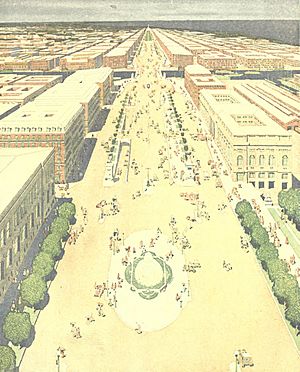
The DuSable Bridge is part of the Michigan–Wacker Historic District. This district was added to the National Register of Historic Places in 1978. The bridge itself was named a Chicago Landmark in 1991. In 2009, the sidewalks and railings were replaced. The new railings look like the original design from 1920.
How Does the Bridge Work?
The DuSable Bridge is a "double-leaf, double-deck, fixed counterweight, trunnion bascule bridge." This means it has two halves (leaves) that lift up. It also has two levels for traffic. The Chicago Department of Public Works designed it. At the time it was built, it was thought to be the first double-deck bridge with roads on both levels. The upper deck was for faster cars, and the lower deck was for slower trucks and deliveries.
Clever Design for Busy Waters
Each half of the bridge is actually split into two parts. This means it works like two parallel bridges. If one part gets damaged by a boat, it can be opened for repair. The other part can still let traffic through!
The bridge uses heavy counterweights to help it open. These weights are hidden below the lower deck. When the bridge opens, they swing down into deep concrete pits. These pits go down 34.5 feet (10.5 m) below the river's surface. The bridge is made of strong steel. It can handle about 30,000 people crossing it every day.
The bridge's towers, called bridge tender houses, are made of Bedford stone. There are four of these houses. The northwest and southeast ones hold the controls for opening the bridge. The other two are just for decoration. Two powerful 108 horsepower (81 kW) motors help open and close each huge bridge half. Each half weighs about 3,750 short tons (3,400 t)!
In the past, the bridge was staffed 24 hours a day. It opened up to 3,000 times a year for ships. But since the 1970s, bridge openings are planned. In spring and fall, it opens twice a week. This allows sailboats to move between Lake Michigan and their winter storage spots.
Art and History on the Bridge
In 1928, beautiful sculptures were added to the outside walls of the four bridgehouses. These sculptures show important moments from Chicago's history.
- The sculptures on the northern bridgehouses were made by James Earle Fraser.
- The Discoverers shows explorers like Louis Joliet, Jacques Marquette, René-Robert Cavelier, Sieur de La Salle, and Henri de Tonti.
- The Pioneers shows John Kinzie leading a group through the wilderness.
- The sculptures on the southern bridgehouses were made by Henry Hering.
- Defense shows Ensign George Ronan during the 1812 Battle of Fort Dearborn.
- Regeneration shows workers rebuilding Chicago after the terrible Great Chicago Fire of 1871.
The bridge also has 28 flagpoles. They usually fly the flags of the United States, Illinois, and Chicago. Sometimes, special flags are displayed for different events.
Explore the Bridge: Museum Fun
One of the bridge's southwest bridgehouses has been turned into a museum! It's called the McCormick Bridgehouse & Chicago River Museum. You can find its entrance off the Chicago Riverwalk.
This museum opened in 2006. It's named after Robert R. McCormick, who used to own the Chicago Tribune newspaper. The museum has five floors and covers 1,613-square-foot (149.9 m2). It teaches visitors all about the history of the Chicago River and the bridge itself.
A really cool part of the museum is the bridge's gear room. During the spring and fall bridge openings, visitors can actually watch the giant gears work as the bridge lifts and lowers! It's a unique chance to see how this amazing machine operates. The museum is small, so only about 79 people can be inside at one time.
In 2019, the museum welcomed its 250,000th visitor. A writer from the Chicago Tribune called the gear room "a little chamber of heaven for infrastructure nerds."
Images for kids


